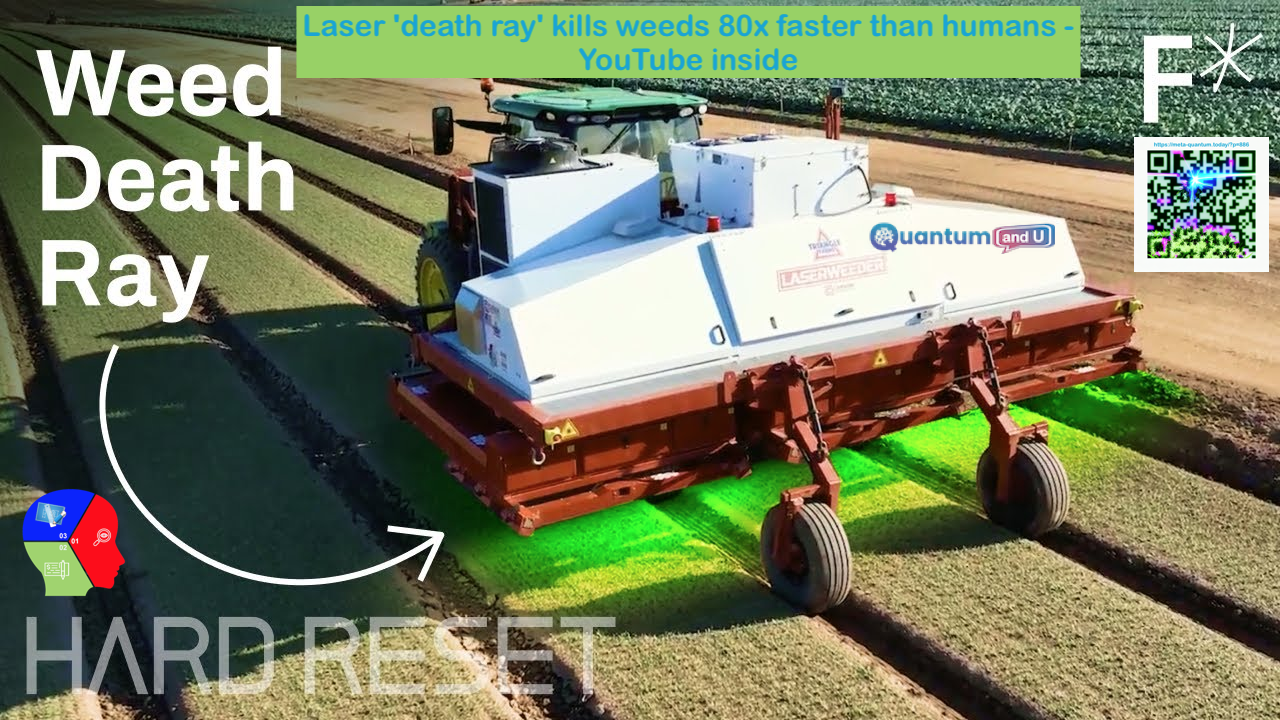
The YouTube video “Laser ‘death ray’ kills weeds 80x faster than humans” on the “Hard Reset” platform, features a groundbreaking technology by Carbon Robotics. The video explores the use of high-intensity lasers and Artificial Intelligence (AI) for efficient weed control in farming. It outlines the traditional challenges of weed control, which are labor-intensive, costly and can damage the environment. Carbon Robotics’ innovative technology uses high-powered lasers and AI to identify and eliminate weeds. The video elaborates on the technology, demonstrating that it can eradicate weeds up to 80 times faster than humans. It discusses how this AI-powered weed-killing robot could transform farming by increasing productivity, reducing costs, and lowering dependency on harmful pesticides. The video also explores potential limitations of the technology and its future implications on the farming industry. It stimulates viewers’ curiosity about the technology’s future and its potential for transforming weed control. The video provides a comprehensive understanding of the motivation behind these weed-killing robots, their potential impact on agriculture, and the persistent issues of weed control in farming.
Related Sections:
- The Weed Problem and the Need for a Solution:
The review begins by highlighting the importance of weed control in agriculture, as weeds compete with crops for nutrients, affecting food production. It explains the traditional methods of weed control, such as herbicides and manual labor, and the drawbacks associated with these approaches, including increasing herbicide resistance and labor shortages. - Introducing the LaserWeeder:
The video introduces Carbon Robotics, the company behind the LaserWeeder, and its founders, Paul Mikesell and Alex Sergeev. The LaserWeeder is presented as the world’s first and only robot that uses AI, computer vision, and powerful lasers to target and eliminate weeds in farmer’s fields. - How the LaserWeeder Works:
The review delves into the technical aspects of the LaserWeeder’s operation. It explains how the robots use high-resolution cameras and AI to detect and track small weeds in real-time. The laser emits thermal energy that destroys the cell membranes and walls of the weeds, effectively killing them. - Advantages Over Traditional Methods:
The video explores the advantages of the LaserWeeder over traditional weed control methods. It discusses how the use of lasers eliminates the need for chemical herbicides, reducing potential environmental impacts and expenses for farmers. Additionally, the technology allows for a significant increase in weed-killing speed compared to human labor.
Conclusion with Takeaway Key Points:
The conclusion of the review emphasizes the potential transformative impact of the LaserWeeder on agriculture. By providing a more efficient, precise, and environmentally friendly approach to weed control, this technology could reduce the reliance on chemical herbicides and manual labor. The review highlights the possibility of adopting no-till farming practices and revitalizing topsoil, which is crucial for sustaining food production. The future vision includes further advancements in AI and laser technology, enabling autonomous farming and data-driven decision-making on a per-plant basis. However, it’s also emphasized that weed control should be viewed as an ecological challenge rather than a war, emphasizing the importance of harmony with the environment.
Key takeaways:
- A Sustainable Weed Control Solution: LaserWeeders represent a game-changing approach to weed control in agriculture. By harnessing AI and lasers, farmers can efficiently target and eliminate weeds without relying on harmful chemicals, reducing environmental impact and health concerns.
- Advancements in Precision Farming: The use of AI and high-resolution cameras allows LaserWeeders to identify and track weeds accurately. This precision farming technique has the potential to revolutionize agriculture, leading to data-driven decision-making and optimized crop management.
- Promising Future Prospects: As technology advances, smaller and more agile LaserWeeders may become ubiquitous on farms, offering greater autonomy and detailed insights into crop health. With the possibility of reducing herbicide use, this innovation can contribute to a more sustainable and productive farming landscape.
In conclusion, the LaserWeeder technology showcased in the YouTube video offers a glimpse into the future of weed control in agriculture. Its potential to minimize herbicide use, enhance precision farming, and contribute to sustainable agriculture makes it a promising solution for modern farming challenges.


